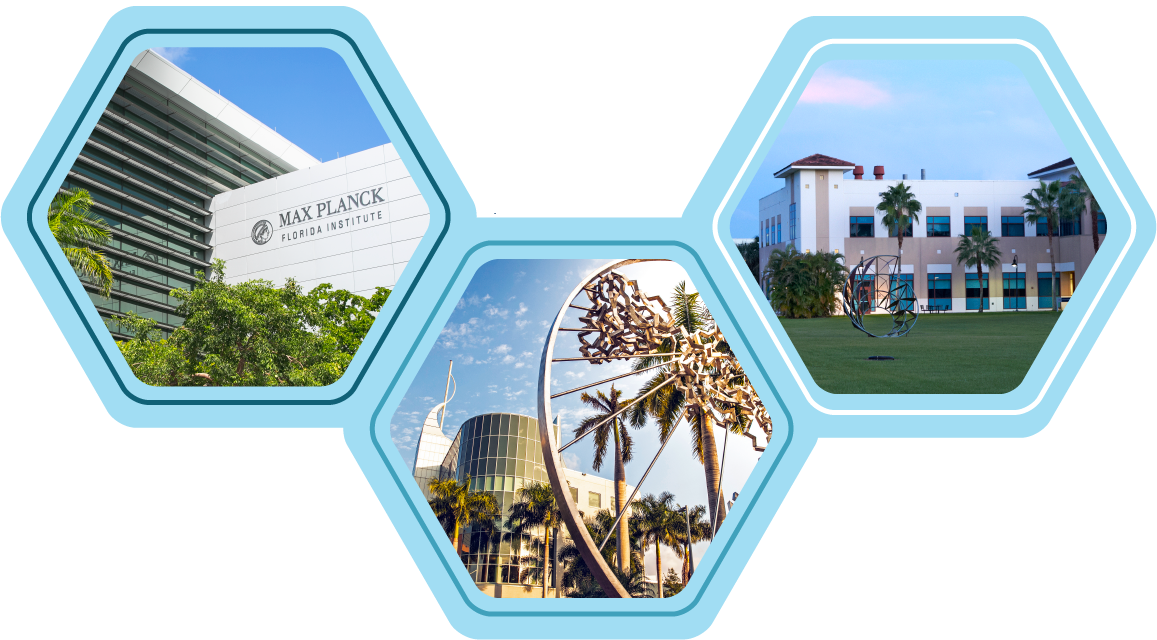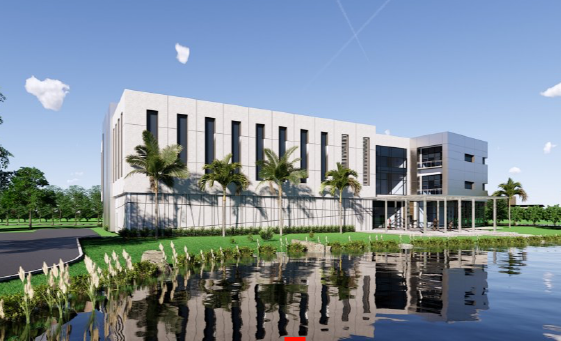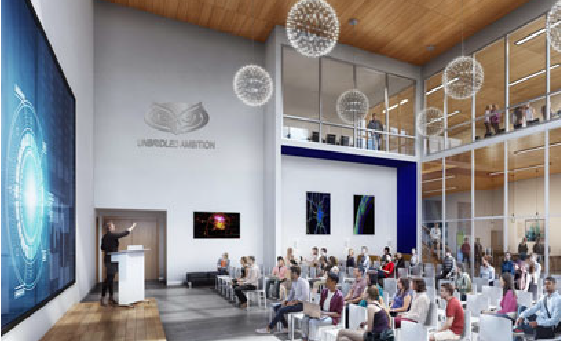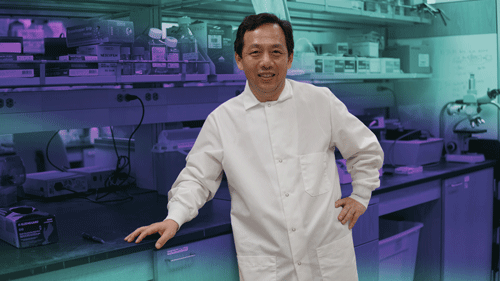

BLAME IT
ON THE BRAIN
Triple Threat Thriving in Jupiter, Creates a Neuroscience Ecosystem With Common Mission
Photography by Alex Dolce i i i
Neuroscience Research Center Rising
Big things are happening on the FAU Jupiter campus. Soon, it will house the new, state-of-the-art neuroscience research building, providing teaching and laboratory space to support enrollment growth in the areas of science, technology, engineering and math (STEM). The $35 million building continues 20 years of progress dedicated to life science research on the Jupiter campus.
In the early to mid-2000s, the Florida governor and legislature earmarked hundreds of millions of dollars to establish a biomedical research park. The investment brought the Scripps Research Institute and the Max Planck Florida Institute for Neuroscience to Jupiter. It’s the only place in the world where the two institutions sit side-by-side and collaborate with university researchers and students. Despite these additions, “we needed to grow more,” said Randy D. Blakely, Ph.D., executive director of FAU’s Brain Institute and professor in the Charles E. Schmidt College of Medicine.

More specifically, the building will expand research and collaborations among the three institutes in the concentrations of neuroscience, biotechnology, bioengineering, data science, and chemistry. “The building will go from molecules to man,” Blakely said. The Center for Comparative Medicine will model and study the mechanisms of brain disorders, such as autism, Alzheimer’s and addiction, while the Center for Cellular Neuroimaging will visualize brain cells by merging computational and virtual reality resources. Additional labs will provide space for supercomputing that examines large data sets from molecules to neural activity.
Blakely said he is excited about what this new facility means for FAU. He expects to have at least 20 principal investigators, a similar number of research faculty and postdoctoral students, and approximately 100 high school, undergraduate and graduate students per year, who will engage in state-of-the-art and technologically advanced research training. “We have a once-in-a-lifetime opportunity for a collaborative recruitment strategy,” he said.

By Judy Gelman Myers
From Darwin to the present, scientists have shown that diverse ecosystems are productive ecosystems. This describes to a “T” the academic seedbed that’s evolved on FAU’s Jupiter campus, where three powerhouse institutions collectively nurture a thriving neuroscience ecosystem and conduct cutting-edge research to better the world.
The ecosystem originally took root in 2013, when a small group of researchers from the Charles E. Schmidt College of Science moved from the Boca Raton campus to the Jupiter campus. Supported by the Provost’s Life Science Initiative and funds from the state of Florida, “ … this group grew, flourished and provided the foundation for the much larger FAU presence that now exists in Jupiter,” said Rodney Murphey, Ph.D., associate vice president for Academic Affairs in Jupiter.
The success of the ecosystem has been driven by diversity, collaboration and a critical mass of researchers from FAU, Scripps Research and the Max Planck Florida Institute for Neuroscience. Each of the three institutions has its own scientific focus, methodology and function, yet they share faculty who collaborate on research and grant applications. Cutting-edge imaging technology owned by one is available to researchers at all three, while seminars and symposia are hosted and attended by researchers from all institutions.
This high level of cooperation enables them to advocate together more effectively for funding and hiring, resulting in a large number of successful grants. “In the scientific world, what’s most significant is the level of interaction that invariably happens between our institutions. I’m really happy to see that,” said Kirill Martemyanov, Ph.D., chair of the department of neuroscience at Scripps. Individually, the three institutions ask different scientific questions. Within FAU, the Brain Institute evaluates neurological diseases by studying molecular changes in animal models, while the Institute for Human Health and Disease Intervention, known as I-Health, takes a clinical approach.
Scripps researchers focus on discovering novel genes and proteins to explore as drug targets.
Max Planck researchers study neural circuits and develop new technologies to make cutting-edge discoveries possible.
Far from hindering collaboration, diversity enhances cross-institutional research. It has yielded high impact papers on topics as varied as signaling processes in the brain, how eating affects sleep in fruit flies, and molecules that can inhibit pathological processes leading to multiple sclerosis.
“Collaborating with people who have different areas of expertise helps you put together a much fuller picture of the problem you’re investigating, making it that much stronger in terms of the depth you can put into specific problems,” said Gregg Fields, Ph.D., executive director of I-Health and adjunct faculty at Scripps, whose laboratory collaborates in research on multiple sclerosis.
Such a diversity of approaches, combined with reciprocity agreements among the institutions, allows a breadth of neuroscientific study not available elsewhere. The Brain Institute oversees the Graduate Neuroscience Training Program, bringing together scientists, educators and students from FAU’s doctoral programs in integrative biology neuroscience, complex systems and brain sciences and experimental psychology, with colleagues from Max Planck and Scripps. And, FAU’s Charles E. Schmidt College of Medicine and Scripps Research have established a dual medicine and philosophy doctoral degree program to provide rigorous training for talented students pursuing a clinician scientist career path.
Because the three institutions are sited within walking distance of each other, scientists also benefit from sharing that occurs outside the lab. Each institution allows the others to use its core facilities, which are equipped with imaging technology relevant to its own scientific pursuits.
That means scientists triple their access to exceptionally rare cutting-edge equipment and proprietary technology, such as Scripps’s genome-wide library of synthesized DNA and RNA molecules and Max Planck’s viral vector technology, which delivers specific genetic material into cells by taking advantage of a virus’s natural ability to carry its genome into a host.
Knowledge sharing is just as critical. Annual events such as Synapse, a networking event for students and researchers; the Jupiter Neuroscience Retreat; and the tri-institutional postdoc seminar bring together faculty, researchers and postdocs to present their work, discuss latest findings, and find out who’s doing what, where.
Meanwhile, critical mass bolsters private sector investment, faculty hiring and grant applications. When potential investors or faculty consider their options, the wealth of opportunities afforded by Jupiter’s neuroscience ecosystem weigh heavily in Jupiter’s favor.
“The fact that everyone’s doors are open to all three partners is an extraordinary opportunity for any scientist who wants to participate in and join this community.
Anytime FAU recruits, we’re able to get the best of the best because of the kind of interactions and the facilities they have at their fingertips,” said Ken Dawson-Scully, Ph.D., a professor of biological sciences at FAU and head of institutional partnerships at Max Planck. When one of the institutions applies for a technology grant, it can bolster its application by citing the other institutions as users.
Healthy ecosystems grow and develop. Randy D. Blakely, Ph.D., director of FAU’s Brain Institute, predicts this one will too. “Scripps and Max Planck continue to invest in the future of the campus. On the FAU side, we’re constructing a building to house new sciences, and there continue to be new collaborative programs. The private sector sees this critical mass and they want to invest. If we hire a scientist, their spouse may obtain an appointment in one of the other units. It’s encouraging biotech companies to move into the area. We have not by any means reached a steady state,” Blakely said. “I’m thinking bigger and better.” ◆

Neuroscience Research Center Rising
Big things are happening on the FAU Jupiter campus. Soon, it will house the new, state-of-the-art neuroscience research building, providing teaching and laboratory space to support enrollment growth in the areas of science, technology, engineering and math (STEM). The $35 million building continues 20 years of progress dedicated to life science research on the Jupiter campus.
In the early to mid-2000s, the Florida governor and legislature earmarked hundreds of millions of dollars to establish a biomedical research park. The investment brought the Scripps Research Institute and the Max Planck Florida Institute for Neuroscience to Jupiter. It’s the only place in the world where the two institutions sit side-by-side and collaborate with university researchers and students. Despite these additions, “we needed to grow more,” said Randy D. Blakely, Ph.D., executive director of FAU’s Brain Institute and professor in the Charles E. Schmidt College of Medicine.

More specifically, the building will expand research and collaborations among the three institutes in the concentrations of neuroscience, biotechnology, bioengineering, data science, and chemistry. “The building will go from molecules to man,” Blakely said. The Center for Comparative Medicine will model and study the mechanisms of brain disorders, such as autism, Alzheimer’s and addiction, while the Center for Cellular Neuroimaging will visualize brain cells by merging computational and virtual reality resources. Additional labs will provide space for supercomputing that examines large data sets from molecules to neural activity.
Blakely said he is excited about what this new facility means for FAU. He expects to have at least 20 principal investigators, a similar number of research faculty and postdoctoral students, and approximately 100 high school, undergraduate and graduate students per year, who will engage in state-of-the-art and technologically advanced research training. “We have a once-in-a-lifetime opportunity for a collaborative recruitment strategy,” he said.

Collaboration on Mind Matters
Three months after Ning Quan, Ph.D., arrived at FAU he received a $1.7 million grant to study interactions among the immune system, the brain and behavior.
That grant, from the National Institutes of Health, foreshadowed a new program to be rolled out under the auspices of the FAU Brain Institute — the Program in Neuroimmunology and Glial Biology (PNGB). This is the institute’s first named program, with Quan as director.
The PNGB seeks to build on recent developments in the field of psychoneuroimmunology. This multidisciplinary science explores the mechanisms by which the immune system engages the nervous system and produces changes in behavior and psychological disease states. The PNGB will also encompass neuroimmune research oriented to brain cancer, brain trauma and fundamental brain mechanisms that do not involve psychiatric disease, as well as research into glial cells – a major, and sometimes ignored, population of brain cells that support the function of neurons and that actively engage in neuroimmune activities.
The program, designed to engage scientists from a wide range of disciplines and institutions, will include faculty from FAU, Scripps Research and the Max Planck Florida Institute for Neuroscience, as well as their postdocs and graduate students. Initially, the PNGB will focus on areas in which FAU research is particularly strong, including underlying mechanisms supporting depression, cognitive dysfunction and pain.

The field of psychoneuroimmunology requires a broader knowledge base. Collaboration, synergy and shared resources, knowledge and tools will be the lifeblood nourishing the program as it grows.
“I speak the language of inflammatory cytokine signaling, but others in the program are more fluent in the language of synapses and circuits,” Quan said. “The goals of our researchers are to learn each other’s language, get out of our little boxes, educate each other and design experiments that reflect more accurately the true complexity of the brain. In this intersection of two complex fields, it sometimes seems like we each are speaking in foreign tongues, but the more we communicate, the more we see the remarkable opportunities for major advances.”